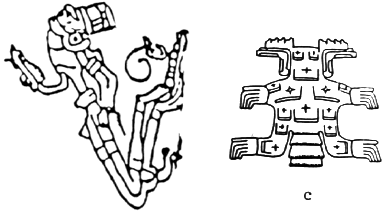| home | Sixth Round Table: Olmec Influence |

|
From the feet themselves projects an element, difficult to decipher, that bears some resemblance to a profile view of the layered tail of the zoomorphic pelt worn by the Atlihuayan "Blind Shaman" (figure 6c). The figure to whom these feet belong is equipped with ear flares and wears a bowler-shaped hat with either a knot or a bone tied to the crown. His forearms are tied together behind his back (an act not only painful for the captive but with the advantage for the captor of thrusting the victim's chest forward), and his legs are tied below the knees. He is most likely a depiction of a bound sacrificial victim.
From the feet themselves projects an element, difficult to decipher, that bears some resemblance to a profile view of the layered tail of the zoomorphic pelt worn by the Atlihuayan "Blind Shaman" (figure 6c). The figure to whom these feet belong is equipped with ear flares and wears a bowler-shaped hat with either a knot or a bone tied to the crown. His forearms are tied together behind his back (an act not only painful for the captive but with the advantage for the captor of thrusting the victim's chest forward), and his legs are tied below the knees. He is most likely a depiction of a bound sacrificial victim. This tragic captive has his eyes closed in death and his belt and loincloth wrenched aside in order to reveal the cause of death--a large cavity in his abdominal area. That the death wound was inflicted in a ritual is implied by the long-necked, flame eyebrowed zoomorph emerging or released or torn from the thoracic cavity of the captive. In Mesoamerica the ritual of human sacrifice is practiced in order to sustain the gods who had shed their own blood and mixed it with maize to create humankind. The gods created man and sustained him with the fruits of the soil; Mesoamerican rulers, as Oscar Wilde said, returned the favor, and in turn nourished the gods with human blood. If sacrificial acts were not performed, then the gods, and in turn the world, would die. Sustaining the gods was one of the primary functions of Maya rulers. The presence of a slaughtered captive, and, as we shall see, other bloodletting iconography on a Middle Formative Period statue implies that, early in Mesoamerican history, capture and sacrifice (Schele and Miller 1986: 209-226) was one of the two great ritual acts on which rulership was visually chartered. |
(to be continued)
![]()
| home | Sixth Round Table: Olmec Influence |